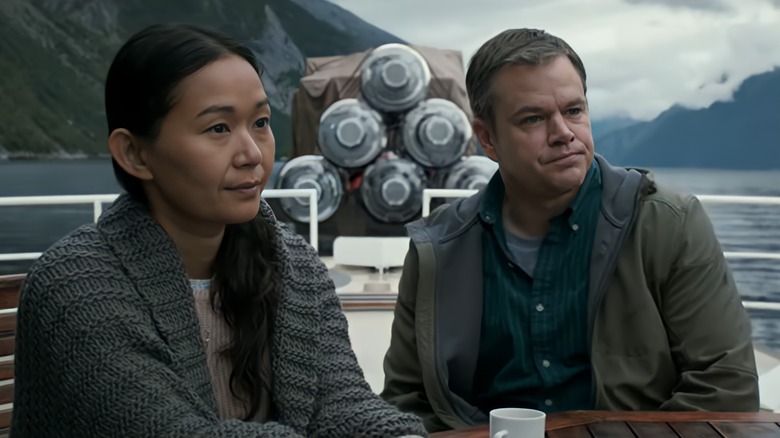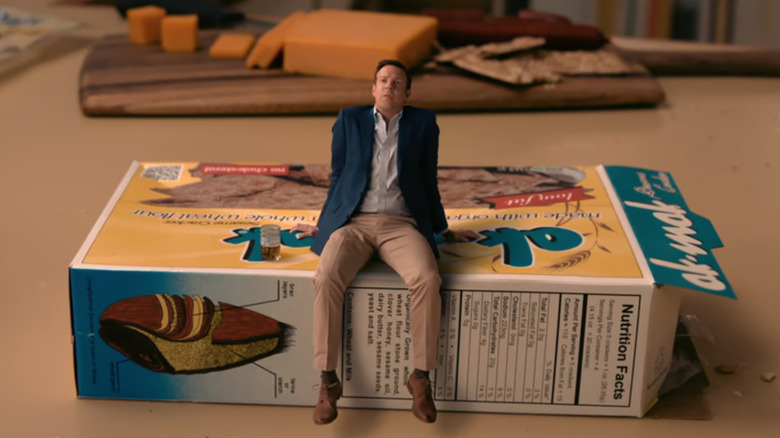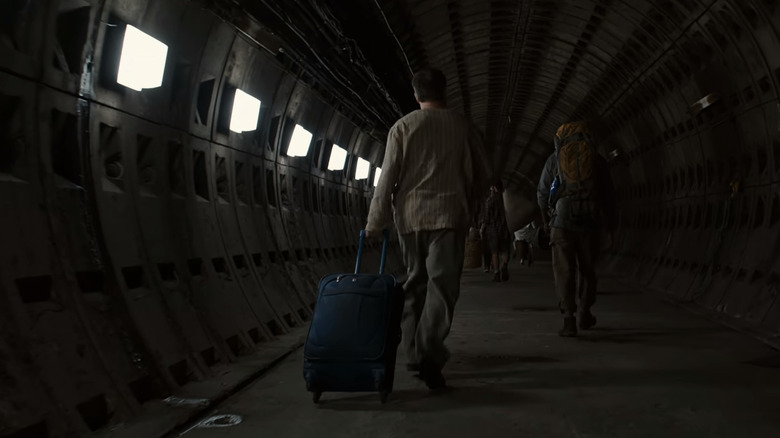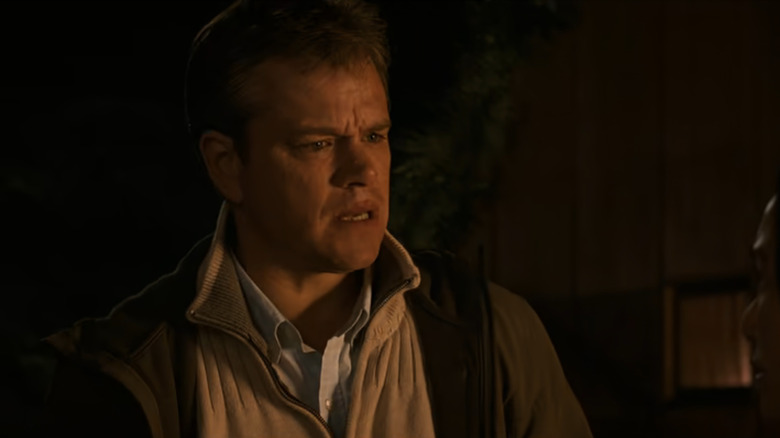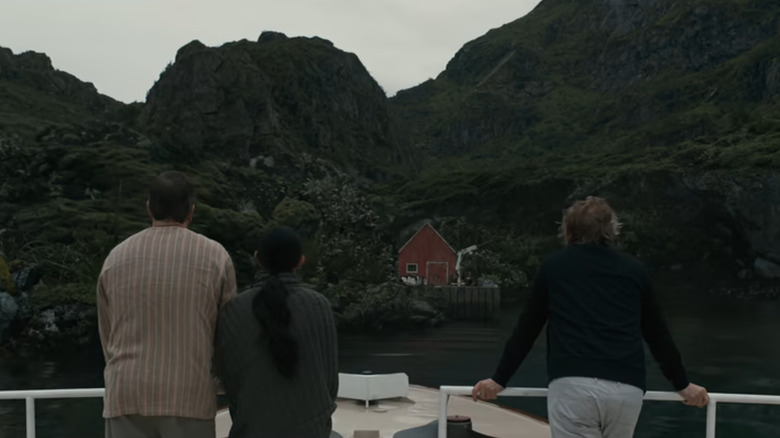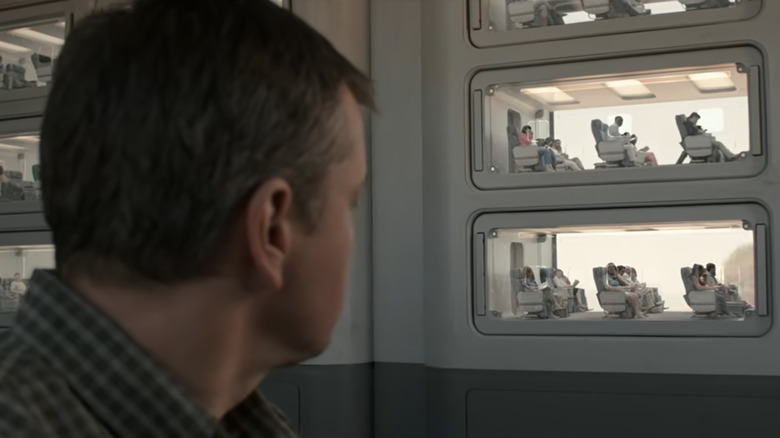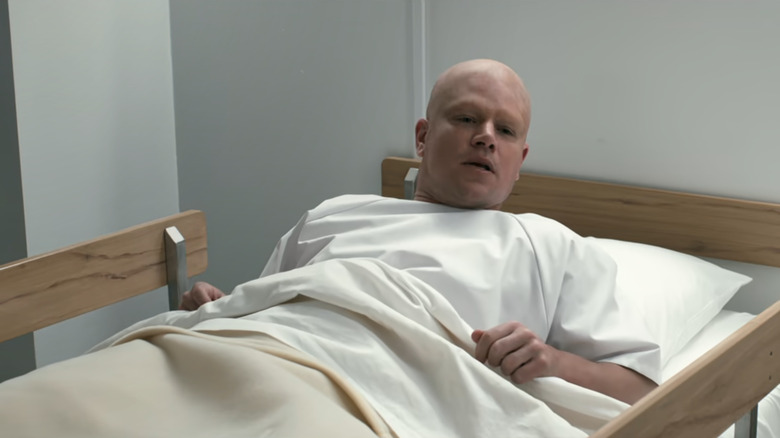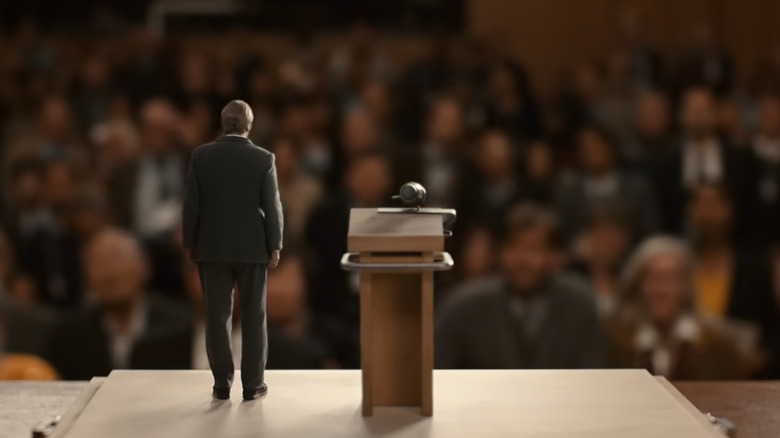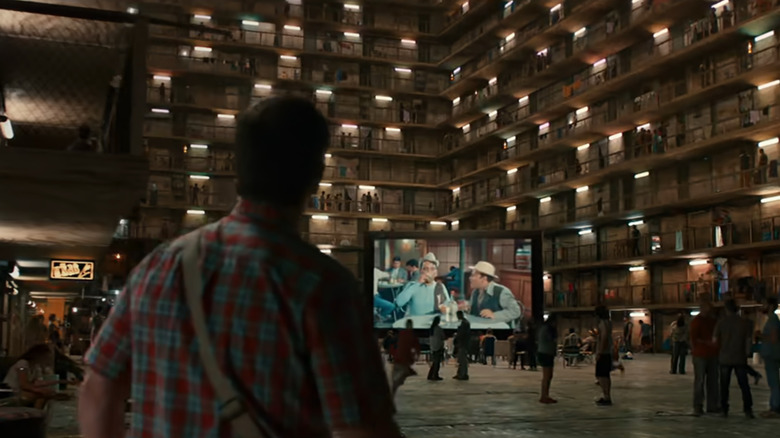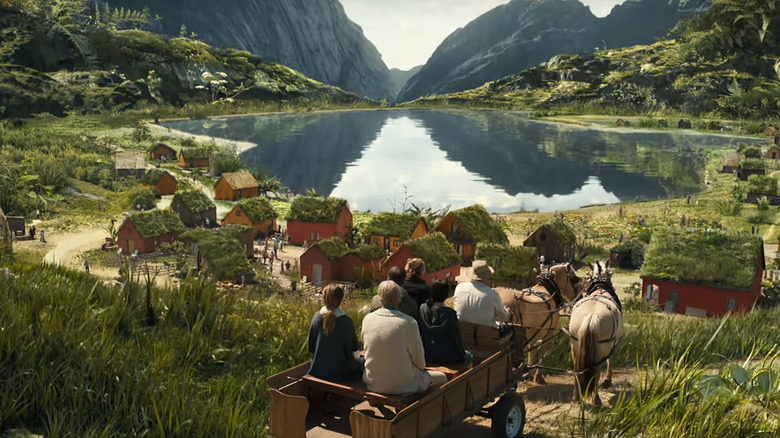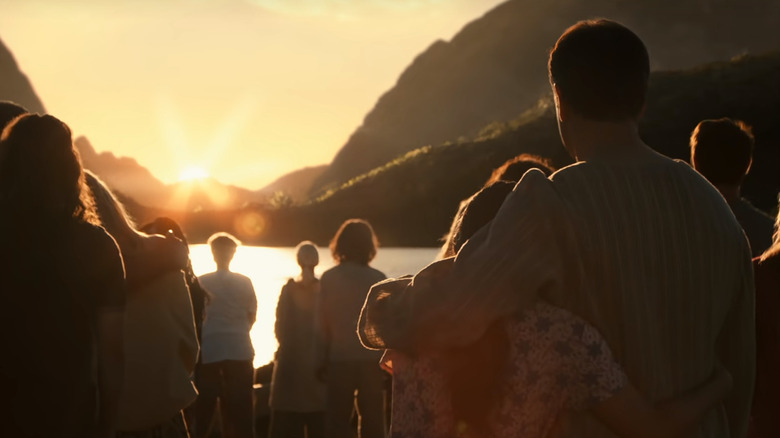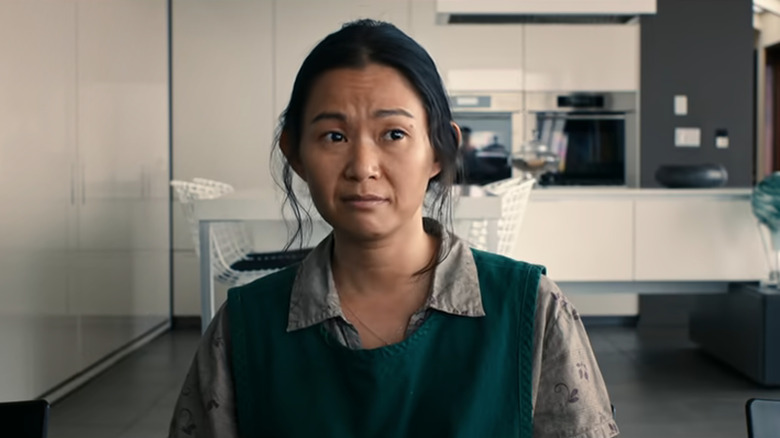The Ending Of Downsizing Explained
"Downsizing" is exactly what it sounds like, a film dedicated to the premise of shrinking. It takes place in a world where scientists have developed the ability to reduce living organisms down to incredibly small sizes. While the title is very literal in this sense, no other aspect of the film is straightforward in any regard.
At first glance, this film presents itself as a lighthearted, sci-fi comedy, and it does make good on this promise ... at first. Audiences meet the film's protagonist, Paul, portrayed by Matt Damon. He's your average Joe, struggling to keep a roof over his head and his wife (Kristen Wiig) in his good graces. However, in a whirlwind series of outlandish events, the story devolves into a much darker social and political satire about class, capitalism, and climate change.
While the film isn't everyone's cup of tea, deemed by some as one of Damon's worst movies, it does offer a unique premise and overall entertaining plot. It's one man's mid-life identity crisis set against the backdrop of existential threat and mass extinction. That's not a terribly overdone trope in cinema, so it's worth a watch. However, given its lack of conventionality, it's also a bit confusing. If the conclusion of "Downsizing" was murky, don't fret, here's a full explanation of the ending.
What you need to remember about the plot of Downsizing
"Downsizing" protagonist Paul Safranek is an everyday man. Each morning, he clocks into his grueling 9-to-5 at Omaha Steaks, goes home to eat some heated-up leftovers, and spends the rest of the night poring over his finances, struggling to find ways to make ends meet. In hopes of escaping this daily grind, Paul and his wife decide to make a grab for the good life by "downsizing," a breakthrough scientific procedure whereby a living organism can be reduced to a pocket-size version of its original form.
When a person downsizes, the world immediately expands. Being so small, they need less of everything: space, food, energy — you name it. Once downsized, Paul and his wife can live like royalty in Leisureland, a high-end miniature city for downsized individuals who own mansions and can buy anything their hearts desire, all for a fraction of what it would cost in the normal-sized world. Paul begins the film on the precipice of eternal happiness, but everything falls apart when he wakes up from his downsizing surgery and realizes his wife has bailed on the whole plan.
Unfortunately for Paul, downsizing is a permanent procedure. There is no going back, and for the rest of the film, Paul is forced to adjust to his strange new reality, struggling to enjoy this life of lonely luxury. As it turns out, the good life isn't all that great when you have no one to spend it with. As his miserable days in Leisureland drone on, one glimmer of hope is provided in the form of his new friends, Ngoc Lan (Hong Chau) and Dusan (Christoph Waltz), who guide Paul on his journey to find a purpose in paradise.
What happened at the end of Downsizing?
Toward the end of the film, Paul embarks on a journey to the original downsized community in Norway with his friends Ngoc Lan and Dusan. This community is home to the original scientists who first engineered the downsizing process, and while Paul is initially in delightful awe to be in the company of such great minds, things quickly take a dark turn.
Soon into this trip, the scientists reveal that there's been a huge release of methane gas in the Arctic, a climate disaster so devastating that it will render the Earth uninhabitable for most forms of organic life. That's right, the world is officially coming to an end. There is nothing that can be done to stop it; however, these scientists have a backup plan. With the help of downsizing technology, they've built a vast underground bunker to ride out the above-ground environmental collapse and ensure the survival of the human race.
At the close of the film, Paul is presented with the option to join the community in the bunker. At first, he's ecstatic about being part of the new world order, and this possibility hopefully provides some meaning to his life, as he could become one of the first to join this final frontier. However, his friends advise him against this, asking that he come back to Leisureland with them. Initially, Paul sticks with his guns and follows the community into the unknown. However, at the last second, right before the tunnel doors close, he turns around and flees the bunker, ultimately returning to Leisureland with Ngoc Lan and Dusan.
Why did Paul choose to return?
Paul's dilemma at the end of the film is influenced by Ngoc Lan and Dusan. Each of his new friends represents one of two ends on the spectrum of humanity, a framework that serves as a guiding orientation for who Paul can choose to be in the world. Dusan is a shady businessman who takes what he wants, when he wants. He's always thinking with his head, and he's quick to point out to Paul that there is no guarantee that the bunker will provide salvation. In his opinion, it's not going to last long, as everyone in the bunker will likely go insane long before the environment collapses. Even if they retain their sanity, it won't be the most comfortable life, nor can the bunker provide any of the amenities the above-ground world offers. Why would you give up luxury on a half-chance gamble?
Ngoc Lan, on the other hand, is a political dissident who has been imprisoned, tortured, and haunted by hardship her entire life. She knows what it's like to need saving, and she's dedicated her life to a mission of helping others, one which she recruits Paul for over the course of the film. She reminds Paul that while extinction is a looming threat, it's not immediate, and there are still people in the current moment whom she and Paul could be helping. The bunker may be preserving humanity, but it's not saving anyone in the present.
With Dusan and Ngoc Lan as the angel and devil on his shoulder, Paul makes a decision about what kind of life he wants to live. Ultimately, he decides that both Dusan and Ngoc Lan are right in their own ways. The bunker is full of hope, but also uncertainty, and there is still important work he has left to do with Ngoc Lan in Leisureland. At the end of the day, he's not a greedy man, a scientist, or an activist — he's just a regular guy who wants to make a positive change in the world while he still can.
Is the world really going to end?
Whether or not humanity is in fact on its last legs is left up to the audience's interpretation. We don't actually see the mass extinction play out, as the scientists estimate it will take at least a few thousand years for total environmental collapse, but the film closes immediately after Paul returns to Leisureland.
There is a lot of evidence to suggest that the end of the world is an inevitability. The scientists in the film are all portrayed as incredibly intelligent and reliable. They did, after all, pioneer a groundbreaking innovation in biological evolution. In all likelihood, they probably know what they're talking about, and the world will indeed be ending at some point in the far-off future.
On the other hand, scientific breakthroughs happen all the time, and downsizing serves as evidence both for and against the scientist's argument. Yes, they've proven their wisdom with this technology, but they also proved that miracles are possible, and there's no telling what innovations may be underway to try to save humanity. In a world where it's possible to shrink people to a few thousandths of their size, it's also within the realm of possibility that someone could invent an equally groundbreaking new technology that can help mitigate climate disaster. Ultimately, the question of whether or not the world ends in "Downsizing" depends on your personal worldview. Who do you side with — the doomsday scientists or the dreamy-eyed hopefuls?
What are the benefits of downsizing?
Downsizing was initially invented as a chance for humanity to save itself from self-assured destruction. Reducing people down to a fraction of their initial size means they need fewer resources and produce less waste. One meal can feed a normal person for a period of a few hours, but it could feed a downsized person for a week or more. A normal person can fill up their trash bag in a few days, but for a downsized person, it could take years, if not decades.
While scientists introduced the technology as a way to slow down the effects of climate change and cut down on environmental pollution, most people in the film do not downsize because they're trying to save the planet. They do it because of the financial perks. Your money is worth a lot more post-downsizing, and for many people, it means a life of total and never-ending luxury. You never have to work again or worry about putting food on the plate for your family. You can live a life of opulence, and you don't have to feel bad about it, because you can still pat yourself on the back and remind yourself that you're also basically an eco-warrior. When you think about it, there's practically no excuse to not downsize. It's all upside!
What are the drawbacks of downsizing?
Even the most well-intentioned innovations come with unforeseen consequences, and downsizing is no exception. We see this theme emerge in the film through subtle moments intertwined in Paul's daily life, either through news stories or personal interactions, all of which suggest downsizing may not be all it's cracked up to be.
As any new technology adopted en masse would, downsizing poses extreme and wide-reaching complications. It has a negative effect on the world economy, as downsized people don't consume goods in large volumes. It complicates foreign affairs, as downsized people can easily travel across borders without any authorization or documentation. It can serve as a vehicle for violence wielded by dictators or power-hungry individuals who may subject others to involuntary downsizing as a means of punishing them or making them vulnerable to attack. It also creates social divisions, as downsized and non-downsized people increasingly develop a bias against the other group and the communities can as a result become further and further polarized.
The film initially includes these complications as background noise to Paul's journey, but he eventually comes face to face with the fallbacks to downsizing after befriending Ngoc Lan. Ngoc Lan is the maid to Paul's neighbor, and unlike many of Lesiureland's residents, she does not live the good life. Even after downsizing, she still has to slave away for the rich and powerful, and she's not the only one. There's a whole class of impoverished workers in Leisureland, bussed to and from their service industry jobs and run-down shanty towns on the outskirts of the city. It turns out that Leisureland only offers eternal luxury to those who can pay for it upfront. If you were poor to begin with, you'll stay poor post-downsizing, it just might be the tiniest bit easier to pay your bills.
Is downsizing good or evil?
After hearing a hard sales pitch on downsizing, optimists may vouch for its undeniable utopianism, while skepticists may be more inclined to suspect it to come with a dystopian catch. The truth is that it's both, and neither. Downsizing offers plenty of benefits to individuals and the world at large, but it does not promise a solution to all problems.
While it was pioneered as a way to save humanity, it was not adopted by the world's population fast enough to prevent environmental collapse. However, not being efficient enough doesn't necessarily make it evil. While downsizing may seem evil in execution when it comes to the impoverished classes of Leisuretown, it did not create those classes. Those people were poor prior to downsizing, and most people who downsize do end up in a better financial position. The truth is, any economy is going to come with service industry jobs, and with that comes plenty of opportunities to exploit workers. That's not unique to Lesiureland, and it actually just mirrors the rest of the global economy.
Ultimately, the question of whether downsizing is good or evil is one that the film never answers in any straightforward manner. Downsizing, like most new technologies, offers its fair share of both. In the end, agonizing over its true nature is actually a fool's game, because the morality of the procedure doesn't really matter in the end. Leisureland is not all the different from the rest of the world and mirrors it in many aspects. Downsizing didn't save the human species, so its existence was almost inconsequential for the world at large. The good versus evil debate here is a red herring, as the real purpose of downsizing in the film is not to make a final moral verdict on miracle technology, but to serve as the vessel for one man's journey, not all of humanity.
What is the message of Downsizing?
The core message of "Downsizing" is that there are no easy answers or sure things in life. Curveballs are always going to come your way. A new technology may be invented, promising you the perfect life, but then your partner could leave you, upending everything you once knew. You could make new friends and find a glimmer of hope in the darkness, only to find out that your days are numbered.
Paul's arc represents the ups and downs of this universally unpredictable experience. From middle-class misery to all-out mid-life crisis and mass extinction, he really goes through the wringer. However, by the end of the film, Paul has abandoned the comforting ethos that things are somehow going to work out, or that there is a right decision he could make to fix everything. The truth is, life just isn't that simple, so the best thing you can do is try to find peace within.
Ultimately, there's no telling what tomorrow may bring. The grass could always be greener, or the world could end tomorrow, so to agonize over the future is to waste the precious time you have. Nothing in this life is promised, so the best way to spend it is to find a purpose, stay optimistic, and try to do a little good in the world.
What has writer Jim Taylor said about the ending?
The ending of "Downsizing" threw many people for a loop. What started as one man's financial and romantic crisis devolved into an existential omen for the future of humanity. When speaking about this topsy-turvy tone setting in an interview with LRM, writer Jim Taylor — who co-wrote the script with director Alexander Payne — commented that, like everything in this film, there are no easy answers. "I've heard a lot of people in the past couple of days say, 'Is it a comedy? Is it a social satire? Is it a doomsday [movie]?'" Taylor said. "I guess my answer to that is it's all of them."
Despite the film's flip-flop nature when it comes to its core messaging, the theme of hopefulness and good nature is one Taylor kept returning to. When speaking about the film's timely commentary on climate change, Taylor said, "It's the way of being most optimistic in which the world is coming to an end."
He also elaborated on the use of this existential threat as a backdrop for Paul's journey. "It's satisfying for a very simple question," he said of the existentialism. Taylor summarized that, in "Downsizing," life as we know it is coming to an end, but Paul makes the choice, ultimately, to try to do good in the world with what time he has left.
Will there be a sequel?
"Downsizing" closes on an open-ended note that leaves plenty of room for a possible sequel or franchise. When speaking to LRM about the possibility of another "Downsizing" film, producer Mark Johnston suggested that it's very much so within the realm of possibility, especially if people are clamoring for it.
"If it's successful enough, we have a lot of material for a sequel," Johnston said. "[We haven't thought about] selling a franchise to the studio, but it could be. If people like it and they go, 'Oh! I want to see where these people go next or before that.'"
Despite Johnston's expressed willingness to take up a possible sequel, there has not been any official news of a new "Downsizing" project in the works. The interview with LRM took place in 2017, when the film was first released, so after several years with no word of development, it can be assumed that a sequel is unlikely (but not impossible).
What could a sequel explore?
While it's unclear whether a sequel will ever actually get to development, one certainty is that there is no shortage of material to expand upon if it does get to that stage. To start, Paul's story is far from over. He's made it past the mid-life crisis and has a newfound purpose to help people, but there's no telling what that mission might look like, or how he'll go about accomplishing it. A sequel could follow Paul on this journey back in Leisureland, or wherever else this mission takes him. Or given the popularity of Hong Chau's character, Ngoc Lan, among critics and audiences, a sequel could potentially continue to follow her character and her humanitarian work.
Another direction a sequel could go in is to explore to the future of the underground bunker Paul abandons. How long will the community survive? Will they go insane, or will they outlast mass extinction and eventually go back to being an above-ground civilization? Also, is the mass extinction going to actually happen? It would be interesting to see how this all plays out in the "Downsizing" universe.
